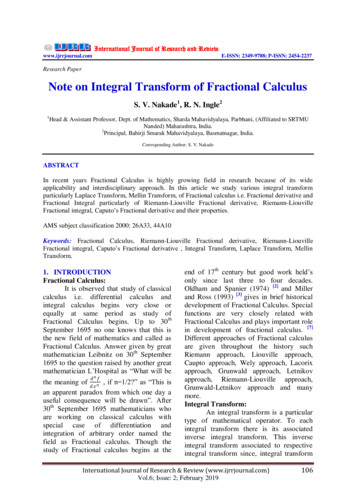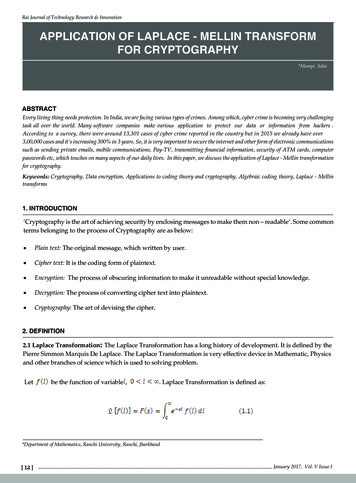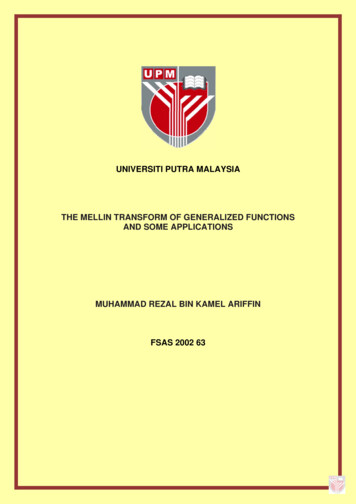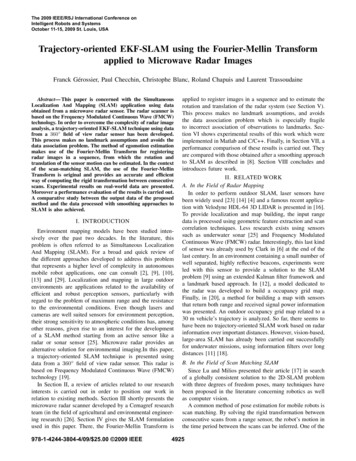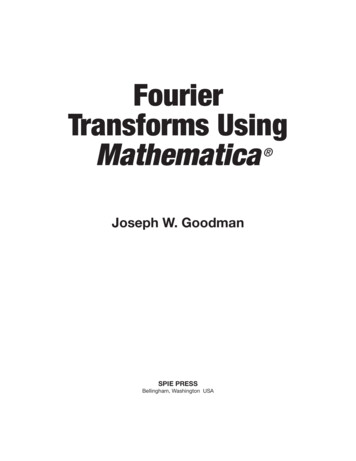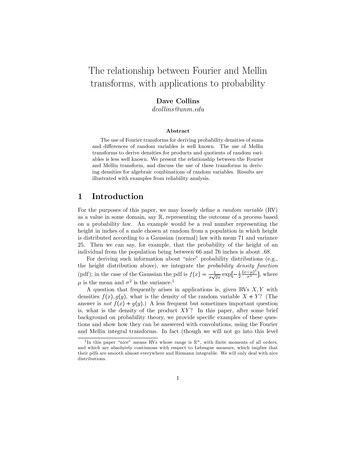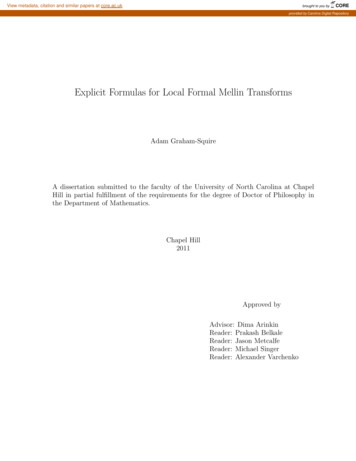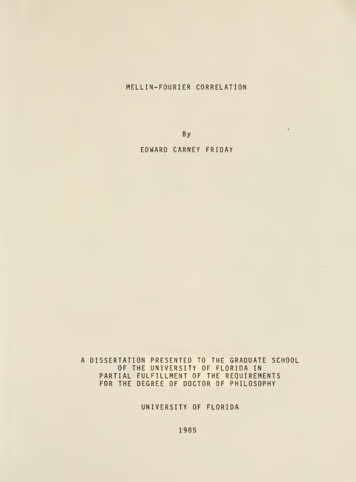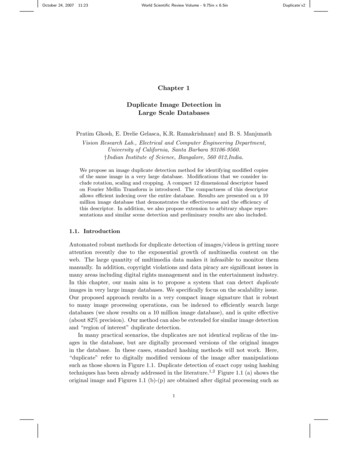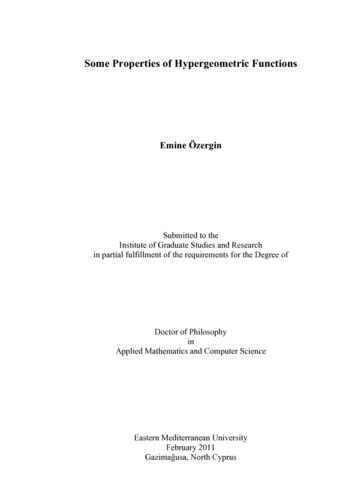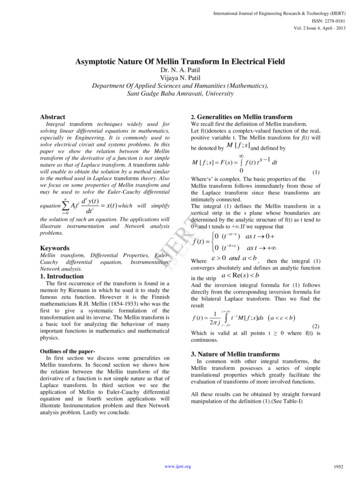
Transcription
International Journal of Engineering Research & Technology (IJERT)ISSN: 2278-0181Vol. 2 Issue 4, April - 2013Asymptotic Nature Of Mellin Transform In Electrical FieldDr. N. A. PatilVijaya N. PatilDepartment Of Applied Sciences and Humanities (Mathematics),Sant Gadge Baba Amravati, UniversityAbstractIntegral transform techniques widely used forsolving linear differential equations in mathematics,especially in Engineering. It is commonly used tosolve electrical circuit and systems problems. In thispaper we show the relation between the Mellintransform of the derivative of a function is not simplenature as that of Laplace transform. A transform tablewill enable to obtain the solution by a method similarto the method used in Laplace transforms theory. Alsowe focus on some properties of Mellin transform andmay be used to solve the Euler-Cauchy differentialnequation Ati ii 0d i y (t ) x(t ) which will simplifydt iKeywordsbe denoted by M [ f ; s] and defined by M [ f ; s] F ( s) f (t ) t s 1 dt0(1)Where„s‟ is complex. The basic properties of theMellin transform follows immediately from those ofthe Laplace transform since these transforms areintimately connected.The integral (1) defines the Mellin transform in avertical strip in the s plane whose boundaries aredetermined by the analytic structure of f(t) as t tend to0 and t tends to .If we suppose thatIIJJEERRTTthe solution of such an equation. The applications willillustrate instrumentation and Network analysisproblems.2. Generalities on Mellin transformWe recall first the definition of Mellin transform.Let f(t)denotes a complex-valued function of the real,positive variable t. The Mellin transform for f(t) willMellin transform, Differential Properties, EulerCauchy differential equation, Instrumentation,Network analysis.1. IntroductionThe first occurrence of the transform is found in amemoir by Riemann in which he used it to study thefamous zeta function. However it is the Finnishmathematicians R.H. Mellin (1854-1933) who was thefirst to give a systematic formulation of thetransformation and its inverse. The Mellin transform isa basic tool for analyzing the behaviour of manyimportant functions in mathematics and mathematicalphysics.Outlines of the paperIn first section we discuss some generalities onMellin transform. In Second section we shows howthe relation between the Mellin transform of thederivative of a function is not simple nature as that ofLaplace transform. In third section we see theapplication of Mellin to Euler-Cauchy differentialequation and in fourth section applications willillustrate Instrumentation problem and then Networkanalysis problem. Lastly we conclude. 0 (t ) as t 0 f (t ) b ) as t 0 (tWhere 0 and a b , then the integral (1)converges absolutely and defines an analytic functionin the strip a Re(s) bAnd the inversion integral formula for (1) followsdirectly from the corresponding inversion formula forthe bilateral Laplace transform. Thus we find theresultc j 1f (t ) t s M [ f ; s ]ds a c b 2 j c j (2)Which is valid at all points t 0 where f(t) iscontinuous.3. Nature of Mellin transformsIn common with other integral transforms, theMellin transform possesses a series of simpletranslational properties which greatly facilitate theevaluation of transforms of more involved functions.All these results can be obtained by straight forwardmanipulation of the definition (1).(See Table-I)www.ijert.org1952
International Journal of Engineering Research & Technology (IJERT)ISSN: 2278-0181Vol. 2 Issue 4, April - 2013Table-ISNOriginal functionMellin Transform2 d n 1 f (t ) s 1 d n f (t ) s 1tdt dt n 1 t 0 dt n 0 F ( s) f (t ) t s 1 dt0f (t ), t 01 d n 1 f (t ) s 2t dtdt n 10 ( s 1) F ( s)f (t )3Af1 (t ) Bf 2 (t )AF1 (s) BF2 (s)4f (at ), a 0a s F (s)5 1 f t F ( s)6f (t a ), a7(t )a f (t ), a 0areal 0 1(5)So that, if we assumef to be of such a nature that thesquare bracket vanishes, we have the relationM [ f n (t ); s] ( s 1) F n 1 ( s 1)(a Re( s 1) b)(6)In similar manner we obtain by induction, (Applingthis rule until we reach F0(s))the Mellin transform of nthe derivative of f (t) is given byF (a 1s)F ( s a)0(3)If f(t) satisfies (1) ,we havef (t ) 0 forRe(s) a 1lim t s 1 f (t ) 0 forRe(s) b 1lim tt 0t M [ f n (t ); s] ( 1) nWhere,(7)s ( s n)( s n 1).( s 1)( s 1)This formula gives the Mellin transform of thederivative in terms of the Mellin transform of thefunction itself.A similar relation is the Mellin transform of theexpression:And hence (3) becomes,M [ f (t ); s] (s 1) F (s 1) d n f (t ) s n 1 d n f (t )M t n tdtdt n 0dt n (a Re(s 1) b) M [ f (t ); s] F ( s) f (t ) t s 1 dt0 sF ( s n)( s 1)(a Re( s n) b)IIJJEERRTTThe Mellin transform of derivative of f(t) can befound by integration by parts to yield M [ f (t ); s] F ( s) f (t ) t s 1 dt0 ( s 1) 1s 1 tf (t ) ( s 1) f (t ) tdt 0s 1 n 1 d n 1 f (t ) f (t )s n 1 d t s n 1 (s n 1)tdt n 1n 1 dtdt 00 t s 1 f (t ) ( s 1) f (t ) t s 2dt 00(8)Where n 0,1,2 .where the function is such that the quantity in thebracket again goes to zero. Repeating the process, weget:(4)And solving same above we get,M [ f (t ); s] (s 1)(s 2) F (s 2)(a Re( s 2) b)But the relation between the Mellin transform of thederivative of a function is not simple nature as that ofLaplace transform. For e.g. d n f (t ) nM t n 1 s s 1 s 2 ndt . s n 1 F s (9)Where F(s) is the Mellin transform of the functionf(t).Other simple relations which can be derived in thesame way are:www.ijert.org1953
International Journal of Engineering Research & Technology (IJERT)ISSN: 2278-0181Vol. 2 Issue 4, April - 2013 d n M t f (t ) ( 1)n s n F ( s ) dt du 1 t g (u )F ( s) ds u 2 j c j u 0(10) du t f g (u )u u 0(.By(1) and(2))And d n M t f (t ) ( 1) n ( s n) n F ( s) dt (11)Table-IIOriginal functionMellin Transform1 s 1 t1t21 s a a1 t a t b b a 3a s5Sin tГ s sin6Cos tГ s cosπs 1c j 2 j c j (12) F ( )d g (t )t s 1dt 1 2 j c j t c j 2 j c j f (t ) g (t )du f u g (u) u0F ( )G( s )d F ( )G(s)Certain types of linear systems give rise to EulerCauchy differential equations.Application of a Mellin transform to this type ofequation will yield an algebraic equation.A Euler‟s Cauchy differential equation is of the form,d i y (t )Ati x(t ) dt ii 0n0iF ( )G ( s )d (15)Where Ai’s are constants.Apply the Mellin Transform using Table-I& III toobtain the transformed equation. i d i y (t ) AM i t dt i M x(t ) i 0 nn A ( 1) F ( s ) t s ds g (u ) u s 1du 1 n ( s ) n F s 1 sF ( s n)( s 1)( 1) n4. Application on Euler-Cauchy differentialequation:F ( )G ( s) t s dsc j d n f (t )dt nd n f (t )tndt n6c j 2 j c j ( 1)n ( s n)n F (s)2(By equation (1))(13)In a similar way the Mellin transform of the productF(s) G(s) is,1 d n t f (t ) dt 52πs( using equation (2))2 j c j 2Г(s)The convolution or faulting theorem for the Mellintransform is derived in the same way as that of for theLaplace Transform. Let us suppose that F(S) and G(S)be the Mellin transforms of the functions f(t) andg(t)respectively; then the Mellin transform of theproduct f(t) g(t) is defined to bec j 1s 1s 1f(t)g(t)tdt g(t)tdtF ( ) t d 0 02 j c j 1( 1)n s n F ( s)4e d n t f (t ) dt 1s a s b 4c j 13 at(14)Table-IIIOriginal functionMellin TransformSNIIJJEERRTTSN sc j i 0ii( s )i Y ( s ) X ( s )Where i is a positive integer and(s)n s(s 1)(s 2).(s n 1)0www.ijert.org1954
International Journal of Engineering Research & Technology (IJERT)ISSN: 2278-0181Vol. 2 Issue 4, April - 2013n1 A 1 s s 1 s 2 i 0. s i 1 Y s X s Y s nii(17)Using the familiar partial fraction method and a Tableof transform pair, the inverse transform of (17) iseasily obtained. Hence for linear Mellin transform thesum of the inverse transform of each fraction is equalto the inverse transform of the sum.5. Application of Mellin transforms in theInstrumentation R ( 2s 5) L 0 s L E ( s 1) ( s 2)( s 3) t e(t ) (3 a) Lt 2 (2 a) Lt 3 Ore(t ) 1with varying current i ( t ) 2 3 , and the resistance,ttR0t.what is the driving voltage of the networkshown in Fig.1 ? 2 a L 3 a 3 t t (22)which is the voltage necessary to provide the givencurrent.IIJJEERRTTR L (3 a) L a s R0 a (by using partials 2s 3Lfraction method)(21)Taking Inverse Mellin transform of both sides byusing Table II, we getIf the current which is measured by a meter in a circuit1(20)Therefore equation (19) becomes, A 1 s s 1 s 2 . s i 1 i 0 2s 5( s 2)( s 3)I (S ) (16)X s 1If the current meter reads, i ( t ) 2 3 thent tthe equation by transforming (Table-II)we get,ii6. Application of Mellin transforms inNetwork analysisWhen the switch S is closed, current i(t) is measuredby a meter in a circuit is given by i ( t ) 1 12 , and theCapacitort t1 co c2 t 2,the resistance,RR 0tfind the drivingvoltage e ( t ) for the network shown in Fig.2 ?The differential equation for Fig.1 is:di(t )di(t ) R0 Ri (t ) L i(t )dtdttOrdi(t )te(t ) L t R0i (t )dte(t ) L(18)Taking Mellin transform, we getFig.2The differential equation for Fig.2 is:di(t )M {te(t )} L M { t} R0 M {i(t )}dtE (s 1) L SI (S ) R0 I (S ) I (S )( R0 L S )(using Table -I)di(t )1 Ri (t ) i (t )dtdtccdi(t ) R0e(t ) L i(t ) 2o i(t )dtdtttORe(t ) L(19)di (0) 0,where i (0) dtwww.ijert.org(23)1955
International Journal of Engineering Research & Technology (IJERT)ISSN: 2278-0181Vol. 2 Issue 4, April - 2013te(t ) L tConclusiondi(t )i(t ) R0i (t ) c0 dtdtt(24)Taking Mellin transform (Table-I & II), we get,E ( s 1) L SI (S ) R0 I (S ) C0I (S )sC L S R0 0 I ( S )s b S a I (S )s a Wherei (0) The use of the Laplace integral transform for some ofthe random variables is mostly used and explained inevery advanced Engineering and Science field, nowbrief theory of Mellin integral transform for electricalEngineering is given in this paper .It seems for anystatisticians, mathematicians and engineers will alsotake interest in developing Mellin transform.Here the paper presented some background on Mellintransform theory and motivated to compute the Euler-d i y (t )Cauchy differential equation At x(t )idt ii 0n(25)iR0Cb 0LLand the application of Mellin transform in differentareas of Electrical Engineering. It is a very effectivemathematical tool to simplify very complex problemsin the area of Instrumentation and Network analysis.di (0) 0dtIf the current meter reads,1 1i (t ) t t2ReferencesEquation by transforming we get,[1]George J. Fikioris “Mellin Transform Method for 2s 3I (S ) ( s 1)( s 2)Therefore equation (25) becomes,b ( 2s 3) L S a s E ( s 1) ( s 1)( s 2)IIJJEERRTT(26)(by using partial fraction method) b L (a b 1) L a 2 2 s 1s 2 (27)Taking Inverse Mellin transform of both sides byusing Table II, we get t e(t ) L (a b 1) t 1 L a b 2 t 22 e(t ) L (a b 1) t 2 L a b 2 t 32Or Integral Evaluation”[2]BogdanZiemian “The Mellin Transformation andFuchsian Type Partial Differential Equations”[3]R. B. Paris, D. Kaminski der D. Poularikas“Handbook of Formulas andTables for Signal Processing”[5]D.Zagier“APPENDIXTHEMELLIN TRANSFORMANDRELATEDANALYTIC TECHNIQUES”[6] Jacqueline Bertrand, Pierre Bertrand, Jean-PhilippeOvarlez “The Mellin Transform” CRC Press inc, 1995[7]Francis R Gerardi “Application of Mellin and HankelTransforms to Networks with Time-VaryingParameters”.[8]P. A. Martin “Some Applications of the MellinTransform to Asymptotics of Series” Peter Lang,Frankfurt,1995[9] Christopher C. Tisdell“Engineering mathematicswookbook”2012[10]A. K. Ghosh“Introducton to Instrumentation andControl”[11] Peter D. Hiscocks “A Laplace Transform Cookbook”Syscomp Electronic Design Limited,March 1, 2008[12]A: R. Forsyth, “A Treatise on Differential Equations,”Macmillan and Co., Ltd., London, Eng.; 1885. bL a 2 2e(t ) 2 (a b 1) t t (28)which is the voltage necessary to provide the givencurrent.www.ijert.org1956
Application of a Mellin transform to this type of equation will yield an algebraic equation. A Euler‟s Cauchy differential equation is of the form, i 0 () n i i i i d y t At x t dt (15) Where A i’s are constants. Apply the Mellin Transfor
